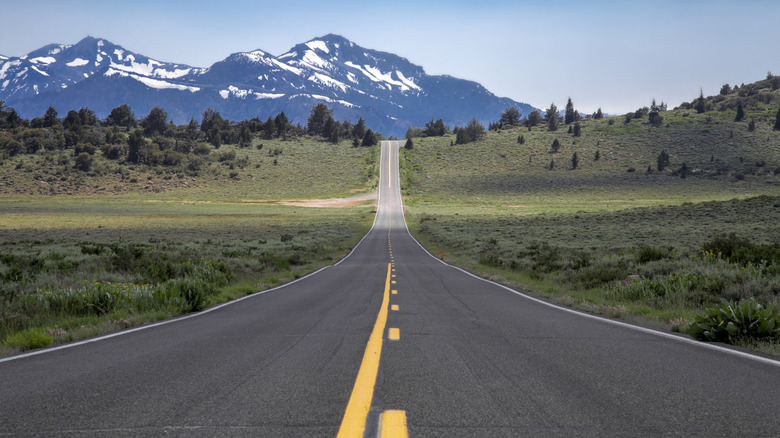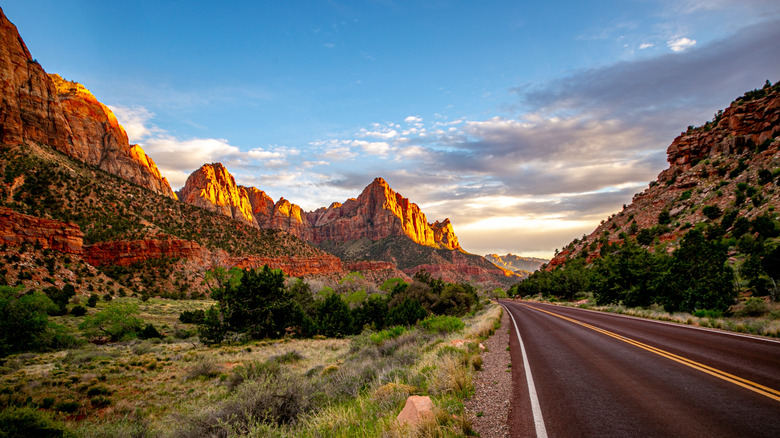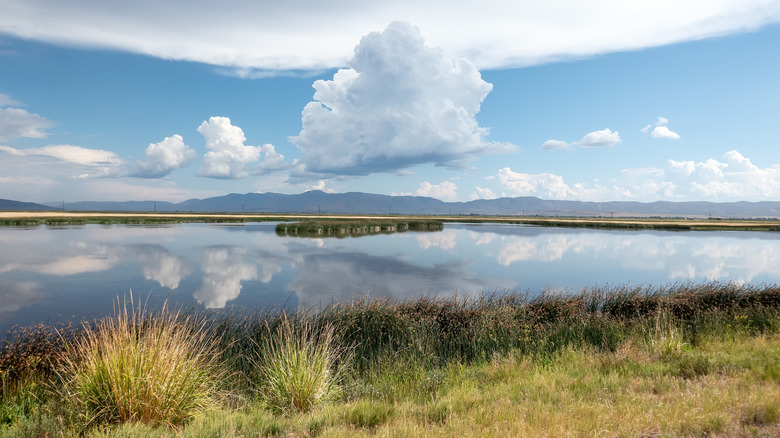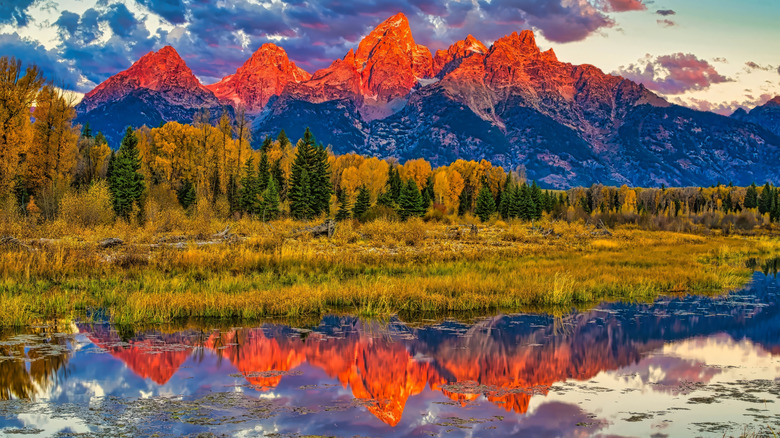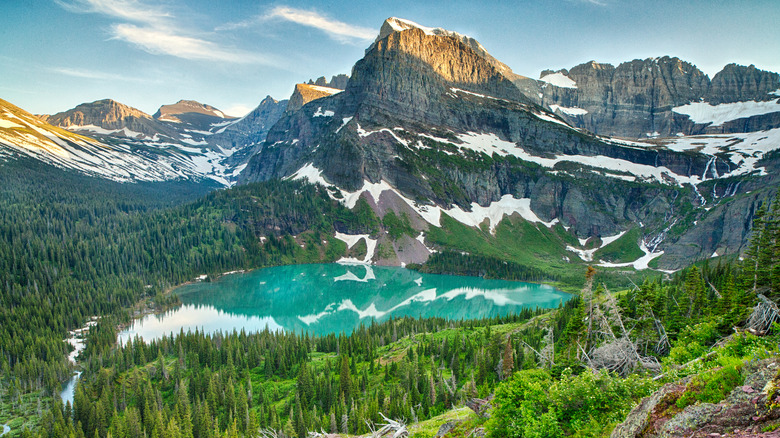Take In The Natural Beauty Of These Western States On This Popular Road Trip Route
We may receive a commission on purchases made from links.
As one might expect from a road that extends almost 2,000 miles, there are countless sites to see along U.S. Route 89. From the more than half dozen national parks to the dozen national monuments that fall along its path, Route 89 has earned the nickname National Park Highway. The roadway, which covers the entire distance between the southern and northern borders of the U.S., runs through a vast array of geographic features and landscapes earning it another moniker — America's Most Scenic Road Trip.
In addition to planning whether you intend to travel the entire length of Route 89 or just a portion of this iconic road, there are also some important tips and tricks to prepare for a road trip ahead of time. Plus, it's vital to plan out your timing. The northern portion of Route 89 is often subject to inclement weather during the winter months, while the southern portion can be brutally hot during the dog days of summer. Additionally, depending on the stops you wish to make along the way, you should make sure to pack appropriate gear for any available outdoor activities. From hiking boots to fishing rods, there are countless pieces of outdoor gear that could be put to use on your trip depending on which states and sights you hope to visit on your road trip. Let's dive into everything you can experience on Route 89.
Arizona
The southern end of U.S. Route 89 is in the Arizona border town of Nogales. As you head north and approach Tucson, you will encounter the first of the national parks found along Route 89 — Saguaro National Park. There is a section of this park — which is best known for having some of the largest cacti found in the U.S. as well as a healthy population of Gila monsters — on either side of Tucson.
Continuing north, you can visit the Desert Botanical Gardens, as well as numerous museums in Phoenix before reaching the historic town of Prescott. Other attractions include the Tuzigoot National Monument and Red Rock State Park, both located in and around Sedona. Then, north of Flagstaff you can see the renown Painted Desert, along with Sunset Crater Volcano National Monument. Of course, the big attraction along this stretch of U.S. Route 89 is the biggest canyon in the country. Just a short distance off Route 89 is the South Rim of Grand Canyon National Park.
Once you're back on Route 89 you will cross the Glen Canyon Dam, behind which sits Lake Powell. Along the shores of Lake Powell is the sprawling 1.25 million acre Glen Canyon National Recreation Area, which straddles the border between Arizona and Utah.
Utah
As you enter into Utah, you will still have plenty of the Glen Canyon National Recreation Area left to explore. Among the outdoor recreation opportunities there are fishing, hiking, boating, kayaking, and camping. Once you've had your fill you will enter 400 miles of the Mormon Pioneer National Heritage Area along U.S. Route 89. There are numerous small, historic towns and villages scattered along this stretch of highway.
The portion of U.S. Route 89 between Kanab and Sevier also features two of the most popular attractions in the state of Utah. Although neither Zion National Park nor Bryce Canyon National Park are actually located on Route 89, each are each a short distance adjacent to it. Both of these parks are extremely popular and offer visitors a dizzying array of outdoor activities, not to mention they both rank among the 17 best fall camping sites in the U.S.
Continuing north, you will find both Dixie National Forest and Fishlake National Forest straddling Route 89. Along the route to Provo, you can enjoy national forests such as the Manti-La Sal National Forest and Uinta National Forest. Fremont Indian State Park is also a short distance off the roadway as well. Before exiting Utah, Route 89 runs through Salt Lake City. North the city, the highway is sandwiched between Great Salt Lake and Wasatch-Cache National Forest before entering Brigham City. From there, a portion of Route 89 is known as Logan Canyon National Scenic as it winds through the national forest to Bear Lake on the Utah-Idaho border.
Idaho
Of the five states U.S. Route 89 passes through, Idaho has the shortest length by far. In fact, this fabled roadway cuts across just the southeast corner of the Gem State. As it enters Idaho, the roadway continues along the western shore of Bear Lake, the northern half of which lies in Idaho. Bear Lake State Park, Idaho's southernmost state park, is a very popular summer destination. If you plan to overnight here, however, be advised that advanced planning is necessary, as the Idaho Department of Parks and Recreation says many of the park's campsite permits will be issued via a lottery system beginning in 2025.
After leaving Bear Lake, Route 89 cuts through a number of small towns in southeast Idaho. Just past the historic town of Montpelier, the road once again enters the Wasatch-Cache National Forest before continuing into Wyoming to the east. Although this portion of Route 89 is relatively short, it is extremely scenic.
Wyoming
The entire stretch of Route 89 in Wyoming runs through the Rocky Mountains. As the highway enters the state, it abruptly turns northward. Along the way up to the town of Alpine, the road is paralleled by the Bridger-Teton National Forest, which encompasses nearly 3.4 million acres of land. Once in the town of Alpine, the road begins to follow the winding route of the Snake River to the town of Jackson. This portion of the road is largely considered to be one of the most scenic stretches of Route 89.
The roughly 150-mile segment of Route 89 from Jackson to the Montana border passes through two of the most iconic national parks in the United States — Grand Teton and Yellowstone. Because there is so much to see and do in each of these national parks, traversing this section of highway can take days. In fact, when planning your trip, it's a good idea to allow ample time to spend exploring each of these iconic outdoor playgrounds. But, keep in mind, it is also bear country. It could be worth knowing when and if you should carry bear spray – such as SABRE Frontiersman – when you are visiting.
Montana
Once you enter Montana, you are officially in Big Sky Country. You are also still in Yellowstone National Park until you reach the town of Gardiner. From there, the road cuts through the Absaroka-Beartooth Wilderness before splitting the Gallatin National Forest and arriving in Livingston. From Livingston to White Sulfur Springs, Route 89 criss-crosses over the Yellowstone, Shields, and Smith rivers — all while skirting the Lewis and Clark National Forest.
North of White Sulfur Springs, Route 89 forms the Kings Hill Scenic Byway as it cuts through the Lewis and Clark National Forest and passes by Sluice Boxes State Park. Beyond that, you'll have a chance to see the five waterfalls on the Missouri River that give the city of Great Falls its name before continuing on to the Blackfeet Indian Reservation. The road continues to bounce along the boundary of Glacier National Park before eventually crossing into Canada.
